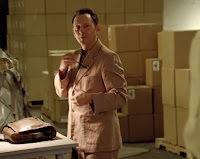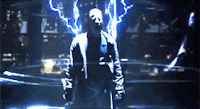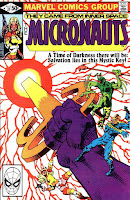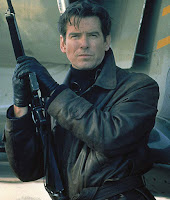Last time we talked about how to write a good script for a B-movie. Something cheap but still solid and clever. Something we can shoot ourselves.
Well, now that the script is written—
(you did write it all out, yes? That was one of the tips!)
—we can move on to the next fun phase. The one we’re all more interested in. Yeah, be honest. What we really want to do is direct. But I think first we need to talk a little bit about what directing involves. Yeah, even on this level.
Y’see, Timmy, making a movie is a lot like being in the military. When you think of the Army, most people tend to think of big battles, shooting rifles, driving in tanks, and stuff like that. But if you talk to anyone in the military (and if you’ve been in, you already know this), there’s a huge amount of logistical work. Planning. Scheduling. Inventories. Duty rosters. It’s all that advance work that makes the shooting rifles/ driving tanks moments go off without a problem.
Well, with significantly fewer problems. We’ll talk about that, too…
Filmmaking’s the same way. So much of it gets done before everyone shows up to set on that first day of shooting, and a huge amount of that work is done by the director. Even with numerous department heads doing lots of work for them, the director’s the one making most of the decisions. And at the budget level we’re talking about, I’m probably going to be doing even more as the director.
This isn’t meant to scare or discourage anyone. I’m just trying to make it clear that a lot of what makes a good director isn’t just the flashy stuff on set when I frame shots with my hands and yell “cut!” And if I want to make a good B-movie, I need to be a good director. Some of the stuff I’m going to talk about is going to sound really boring, and more than half of it’s going to happen before the first time I get to yell “action!” Yay! Welcome to filmmaking!
So here’s a few things I should probably have if I want to do a better-than adequate job of directing. Especially at our B-movie budget level.
1) Have Some Experience
This is the easiest one. Not saying I should’ve already shot another movie or some shorts or anything like that. But before I get a dozen of my friends together… I should just play around with the camera a bit. Even if I’m just planning on shooting this on my phone, go spend some time with the phone. Figure out what it can do. Believe me, it’s a lot better to figure it now than when all your friends are standing around ready to shoot a scene.
Easy thing to do? I should think of shots I like in movies, shots I’ve imagined for my movie, and just try to do them. No pressure, no requirements, just see if I can make my camera do the thing I’m picturing in my head. Maybe use action figures or get a friend who’s willing to be my living mannequin for the day and try a bunch of different shots with different angles/ lighting/ costumes. Then look at these shots and try to figure out what needs improvement. Spend lots of time doing this.
Seriously, start doing it tonight. Start doing it right now. Point the camera at the cat and give me a serial killer POV shot—go!
You’ve done that already? For real, you’re not just saying it so you can rush to the next step? Well, okay than…
2) Have the basics down
Okay, in the past I’ve talked about some standard film shots, so here’s a link for those. I want to start thinking of the script in these terms. Visually, what each scene’s going to look like and which shots I’ll need to construct that scene.
I’ll also point you at Krishna Rao’s unwritten rule of thumb—one pretty shot a day. Maybe I want to do a neat POV shot on a slide or outside someone’s window. Maybe I’m going to use a bicycle to keep up with somebody running down the street. Maybe my friends and I figured out how to do a real cool overhead spinning shot. These are all fantastic, but I don’t want to get bogged down in dozens and dozens of them on the same shooting day (I’ll explain why in a bit).
 Let me hit you with two more good things to know. There’s a term you may have heard called screen direction. It’s really important, and it’s one of those things we all instinctively notice when its done wrong. Really simply put, pretend there’s a line down the center of the camera frame. Everything has to stay on its side of the frame, unless we see it switch sides on camera. Things on the left stay on the left, things on the right stay on the right. If you’re on the left and I’m on the right, I should be looking left (at you) when we’re talking in close ups and you should be looking right (at me). If we’re both looking the same way it looks.. weird. It goes against the visual cinematic language we’ve all picked up over the years.
Let me hit you with two more good things to know. There’s a term you may have heard called screen direction. It’s really important, and it’s one of those things we all instinctively notice when its done wrong. Really simply put, pretend there’s a line down the center of the camera frame. Everything has to stay on its side of the frame, unless we see it switch sides on camera. Things on the left stay on the left, things on the right stay on the right. If you’re on the left and I’m on the right, I should be looking left (at you) when we’re talking in close ups and you should be looking right (at me). If we’re both looking the same way it looks.. weird. It goes against the visual cinematic language we’ve all picked up over the years.
 Now, there’s another aspect to this and it’s called crossing the line. Here’s how it usually gets explained. Natasha and Yelena are sitting at the kitchen table eating breakfast and the box of cereal’s on the table with them. When we shoot our master shot, these things are going to be on one side or the other—some people say it’s with her or with her For example, Yelena’s bowl of cereal would clearly be with her, Natasha’s bowl is with her. But the box… who’s the box with? Because if we try to shoot it with both of them, it’s going to jump back and forth on screen as it crosses the line. If the camera’s facing Yelena, it’ll be on the left, but if it’s facing Natasha now it’ll be on the right. Make sense? Look, I even included helpful visuals. Again, it’s going against that cinematic language. So we need to make a decision and stick with it (I’m saying the cereal is with Natasha).
Now, there’s another aspect to this and it’s called crossing the line. Here’s how it usually gets explained. Natasha and Yelena are sitting at the kitchen table eating breakfast and the box of cereal’s on the table with them. When we shoot our master shot, these things are going to be on one side or the other—some people say it’s with her or with her For example, Yelena’s bowl of cereal would clearly be with her, Natasha’s bowl is with her. But the box… who’s the box with? Because if we try to shoot it with both of them, it’s going to jump back and forth on screen as it crosses the line. If the camera’s facing Yelena, it’ll be on the left, but if it’s facing Natasha now it’ll be on the right. Make sense? Look, I even included helpful visuals. Again, it’s going against that cinematic language. So we need to make a decision and stick with it (I’m saying the cereal is with Natasha).
When people mess this up, it’s usually because they’re confusing the actual geography of the location—what they’re seeing with their own eyes—with what the audience is seeing through camera. It doesn’t matter where the cereal box actually is in relation to you or me. Even if it’s actually at the middle of the table, on camera, it looks closer to you and that’s how we established it, so that’s how we need to shoot things. As far as the camera’s concerned, it’s on your side, not my side.
A fantastic example of screen direction (done right) is the first swordfight in The Princess Bride. Even with all the leaping around and changing camera angles, Inigo and the Man in Black never switch sides. He’s always on the left, he’s always on the right. The only time it changes is when we actually see them physically switch sides on camera.
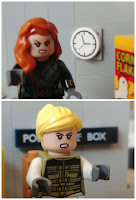 Something I touched on above, closely related to crossing the line, is eyelines (this is the second of those two good thing to know). Have you ever watched a movie or TV show and someone seems to be looking off over there somewhere, not at the person they’re talking to? That’s an eyeline issue, and a lot of the time it ties back to crossing the line and/or people thinking more about geography then camerawork. The actors are looking at where their co-star is in the room, not where the camera’s told us they are.
Something I touched on above, closely related to crossing the line, is eyelines (this is the second of those two good thing to know). Have you ever watched a movie or TV show and someone seems to be looking off over there somewhere, not at the person they’re talking to? That’s an eyeline issue, and a lot of the time it ties back to crossing the line and/or people thinking more about geography then camerawork. The actors are looking at where their co-star is in the room, not where the camera’s told us they are.
ProTip—most of the time if I’m close on Yakko and he’s looking at Phoebe (but we don’t see her), he’s actually just looking an inch or two away from the camera lens. Left or right of the lens depends on which side of the frame Phoebe was on. It seems weird at first, but it looks right when you cut it together.
Yeah, I know. It’s a lot of stuff to keep track of. We should probably be making a list.
Speaking of which…
3) Have a shot list
Okay, up above where I talked about different shots? This is where I need to start figuring out which of them I need for each scene. Seriously—before the first day of filming, I should know every shot I need/want for every scene.
For example… scene one. The walk-and-talk scene outside the office building. Most of it’s just going to be a wide shot of Wakko and Dot walking, but I might want to get some overs for the last third of their conversation. I might not want to go in for coverage yet because (theoretically) tension levels are still low.
But that sword fight in the forest? Well, I’ll probably want masters from both directions, and some overs to get the swords in, plus tight on their faces for a few reaction shots. And this might be a good place for one of those pretty shots—maybe a really big camera move at a good part of the duel.
I need to do this for every scene in the script. Picture all of it in my head—how its going to look on screen—and then figure out what I’m going to need to make that happen. Yeah, it can be a lot of work—I’ve seen directors spend three or four days on a shot list just for a formula television show. I knew one guy who’d block all his shots out with action figures.
Here’s two quick pro tips about making shot lists….
First, I should remember that being in close to someone tends to give us more emotion, so I usually want to start wide to establish things and then go tighter to connect with the characters. There’ll be exceptions sure, but this is a great rule of thumb. It works for scenes and for the movie as a whole. The scenes at the start of my movie should be shot wider and looser, giving me some space to breathe, but they get tighter as the story progresses and tension builds. Seriously—go watch one of your favorite movies and see how many close-ups there are in the first few scenes as opposed to the scenes closer to the climax.
 Second, when I print out my script (because I wrote out the whole script, right?), three-hole punch it and put it in a binder. Seriously, movie sets pretty much run off three ring binders. And one of the reasons why is that—if I printed my title page—every page of the script now has a blank page right next to it (the back of the previous page). I can fill that blank space up with the shots for that page, notes to myself, diagrams, all sorts of stuff. Now it’s all right there, right next to the relevant scene.
Second, when I print out my script (because I wrote out the whole script, right?), three-hole punch it and put it in a binder. Seriously, movie sets pretty much run off three ring binders. And one of the reasons why is that—if I printed my title page—every page of the script now has a blank page right next to it (the back of the previous page). I can fill that blank space up with the shots for that page, notes to myself, diagrams, all sorts of stuff. Now it’s all right there, right next to the relevant scene.
As sort of a subset to the shot list, I should know how I want every scene to make the audience feel. Is this a scary movie? A funny movie? Should they be thrilled by the action or the romance in this scene? And it doesn’t always have to be big reactions—they can be intrigued or hopeful or kind of sad. But it probably means something if I have a scene and I’ve got no idea how the audience is supposed to feel about it. Or if those feelings don’t really line up with the scenes around them.
4) Have a shooting schedule
So our script has a bunch of locations in it. An office building. A tent. A forest. A meadow. I probably want to make sure I’m listing the inside and outside of places as two different locations, so Interior: Office and Exterior: Office. This can come in handy later.
What I need to do now is figure out the best order to shoot things in that also works with when we can get those locations. Like, I can shoot inside the office during the week after 6:00PM, but it’s a two hour drive to the forest, so we need to that on the weekend. Also, that walk and talk outside the office is during the day, but we can only do that on the weekends, too. Plus, Wakko’s busy on the third weekend of the month, so he can’t be in anything then.
Plus… well, you may remember last time I mentioned a good rule of thumb is that it’s going to take 90 minutes to shoot a properly formatted page. Just to be safe, I should probably double that for pretty shots and/ or stunt stuff. So that page of swordfighting—I should plan on three hours to film that.
What I’m getting at is I also have to factor in how long we need to be shooting at each location. We may need the office for twenty hours altogether. Add in that we can’t get in there until after 6:00… it means we’re probably going to have to spread this over three nights of shooting. But not over the weekend Wakko can’t be there. Unless… we just do the two scenes he’s not in on that weekend.
This is why so many movies shoot stuff out of sequence. Yeah, those four office scenes are all through the script, but it makes a lot more sense to shoot them all at the same time. And the meadow and the exterior tent are almost forty minutes apart in the movie, but… well, is there any reason we couldn’t set up the tent in the meadow once we’ve shot the meadow stuff? We could just turn the camera a bit for a different background and bam exterior tent.
 Yeah. It’s a bit of a puzzle figuring out how to make all of this work. It always is. I have friends who are assistant directors and I’ve watched them juggle these things back and forth, trying to make everything line up as best they can. Trying to work this all out will probably be when we’re doing a lot of begging and pleading and desperate promising with various people. Because we’re doing all this super-cheap, mostly off people’s goodwill, so we need to make everyone happy. This is my dream, but it might not be theirs.
Yeah. It’s a bit of a puzzle figuring out how to make all of this work. It always is. I have friends who are assistant directors and I’ve watched them juggle these things back and forth, trying to make everything line up as best they can. Trying to work this all out will probably be when we’re doing a lot of begging and pleading and desperate promising with various people. Because we’re doing all this super-cheap, mostly off people’s goodwill, so we need to make everyone happy. This is my dream, but it might not be theirs.
Also, now that we’ve got this all these different scenes set down in shooting order, I can see that oh, crap… I’ve got three of my pretty shots scheduled for Tuesday night. Do I really need all of them? Which one’s going to add the most to the story I’m trying to tell, to give it the most dramatic weight at a key moment? I should probably aim to get that one done and put the others aside for now.
Again, like the shot list, everything will go sooooooo much smoother if we work this stuff out ahead of time. In fact…
5) Have Everything Prepped Beforehand
I’ve really gotten into cooking videos over the pandemic and I’ve basically watched… well, 90% of Binging With Babish at this point. In one of his Basics videos, Andrew talks about having as much prepped beforehand as possible when you’re cooking. Cut all the veggies. Weigh all the ingredients. Make sure all the pots and plates are clean. The less I have to do once the water’s boiling, the less chance there is I’ll mess this up.
I want to be the same with my movie. Know who’s bringing snacks and drinks to set. Know who’s bringing everything to set—if something’s supposed to be there, who’s bringing it? Me? You? Her? Have all the costumes ready to go beforehand—even if they’re wearing their own clothes, know which clothes they’re wearing. Have locations lined up and scouted and confirmed. Have the swords picked out. Any decision I can make before we all get to set is one less decision I have to make on set.
Because when I’m on set, I want to be focusing on getting this shot from my shot list, not figuring out if Phoebe should be wearing leather armor or chainmail in a scene we’re shooting four days from now.
6) Have Lighting and Sound
Okay, so… odds are pretty good we were thinking of spending some money on camera equipment. Maybe the camera itself. Maybe we’re using our iPhone to shoot this and we want to get one of those smartphone steadicam rigs. Or even just some selfie sticks and a few stands to prop it up on.
Here’s what I’d do. Right now, I’d think of the number I was willing to spend on the camera and cut it in half. Seriously, whatever I was thinking of getting, odds are I can find a cheaper version of it online. Yeah, we want good equipment, but let’s be brutally honest—at this budget level it’s all going to be kind of the same.
Then I should take the other half of that money I’d budgeted for camera and spend it on lights and sound. Yeah, I’ve mentioned lights a few times. Trust me, it matters. It will make a gigantic difference, just having a few lights I can aim and throw some diffusion over (diffusion in this case is wax paper, unless we’ve got access to a theater department and their gel cabinet (in which case, I want a few general purpose frosts)).
 The only thing that can make a bigger difference than lighting is sound. So many B-movies these days have absolutely awful sound because those filmmakers try to just use the microphone on their camera and nothing else. But we’re smarter than that. We can just put a recording app on everyone’s phone, buy two or three cheap lav mics, and voila we now have better sound than half the indie B-movies out there. Just remember to clap really hard at the beginning of every take—one clap that all the mics can pick up. Now you’ve got something to sync all the different recordings to when you edit.
The only thing that can make a bigger difference than lighting is sound. So many B-movies these days have absolutely awful sound because those filmmakers try to just use the microphone on their camera and nothing else. But we’re smarter than that. We can just put a recording app on everyone’s phone, buy two or three cheap lav mics, and voila we now have better sound than half the indie B-movies out there. Just remember to clap really hard at the beginning of every take—one clap that all the mics can pick up. Now you’ve got something to sync all the different recordings to when you edit.
Yeah, that’s what the little clapper board’s for. It’s usually a digital sync these days, but for our purposes the old ways work just as well.
Told you this’d be educational.
7) Have a production meeting
Another term you’ve probably heard before. Maybe a week or so before we want to start shooting, I want to get everyone who’s going to work on this together. Not the cast members—all the people who are going to be behind the camera helping with costumes, props, lighting, locations, and well… the camera. And, yeah, at this budget level there’s a good chance some of them will also be cast members, but I’m not thinking of them that way today.
 What I want to do is go through the entire shooting schedule page by page, with the script right next to it. If the very first thing we shoot is scene 23, then let’s go to scene 23 and make sure we’re all, so to speak, on the same page. We know where it is, who’s in it, what’s in it, if we need anything special for it (is this that running scene we need the bicycle for? Who’s got the bicycle?). We’ll go through the first day of the schedule, the second day, and so on.
What I want to do is go through the entire shooting schedule page by page, with the script right next to it. If the very first thing we shoot is scene 23, then let’s go to scene 23 and make sure we’re all, so to speak, on the same page. We know where it is, who’s in it, what’s in it, if we need anything special for it (is this that running scene we need the bicycle for? Who’s got the bicycle?). We’ll go through the first day of the schedule, the second day, and so on.
Now, in all fairness, I know a few of my friends who are Assistant Directors will roll their eyes at me about this, because there are those folks who prefer to just read straight through the script and do the production meeting that way. This is an option, yeah, but in my experience sooooo many low budget films and shows had problems that tied directly back to people not being clear that A and B were (or weren’t) happening on the same day. Or that we were going to film Y a week before we shot X. And that’s stuff that won’t come out by just reading the script.
We can do it either way but personally… I’d go with the shooting schedule. This meeting’s about making the movie, not watching it.
Also have snacks and drinks at the production meeting, even if it’s just chips and bottled water. Have something. All these people are here doing me a favor. Thank them for it constantly.
8) Have a read-through
Guess what? Now we’re going to go through the script in order. Maybe a day or three after the production meeting, I want to get my whole cast together, maybe order a pizza or three, and all of us read the script together. They all read their parts, I read everything else. This is when they get to all play off each other, get a sense of timing, get a sense of how they’re going to play their characters. I can get a sense for how the dialogue sounds, maybe tweak a few lines here or there, perhaps even suggest a few things now so –again—I’m not dealing with it on set. This is also a chance for everyone in the cast to just meet each other (assuming they don’t all know each other already) so they’re a little more relaxed on set that first day of shooting.
ProTip—this is a great time to take a couple random photos of people if my movie needs them. If the script calls for a casual picture of Wakko, or maybe a shot of Dot and Phoebe together for their phones, get them now. They’ll be in different clothes in a different setting, so they won’t look staged or photoshopped. Also, this may be the only time you have some people together who never actually share a scene in the movie (and might be scheduled for different days).
And now… we finally get started. It’s our first day of shooting, everyone’s together, and I’m about to take my place in the annals of film history as a director. So here’s two last things for me to keep in mind.
9) Have a Plan B!
Look… things are going to go wrong. Sometimes at the last minute. We’re going to lose that location. That actor’s going to get sick. The guy in charge of bringing the sword is going to forget the sword. It’s going to rain on the day of our big sunny scene. And it’ll rain really hard, believe me, because God hates us, and he hates that we’re actually making our movie while his is stuck in development hell.
 While it’s good to have everything planned out, like I’ve said a few times above, it’s also good to have a few alternate versions in my head in case something goes wrong. Because things going wrong is really common at this budget level. It’s unavoidable. So I need to be flexible. Do I really need Wakko in this scene? Is there a way to do it without the sword? If I really need the sword, could this scene happen somewhere else, location-wise? Is there something else that could happen here today instead with the actors we have? Like could this office scene somehow happen outside the office building—or outside a different office building?? And maaaaaaybe one of the meadow scenes could happen here in the office? We’ve got all the actors to do that, right? See, this is another time a shooting schedule will come in handy. Or maybe Wakko’s really sick so we just do the meadow scene now and the office scene will happen much later inside an… elevator? Parking garage?
While it’s good to have everything planned out, like I’ve said a few times above, it’s also good to have a few alternate versions in my head in case something goes wrong. Because things going wrong is really common at this budget level. It’s unavoidable. So I need to be flexible. Do I really need Wakko in this scene? Is there a way to do it without the sword? If I really need the sword, could this scene happen somewhere else, location-wise? Is there something else that could happen here today instead with the actors we have? Like could this office scene somehow happen outside the office building—or outside a different office building?? And maaaaaaybe one of the meadow scenes could happen here in the office? We’ve got all the actors to do that, right? See, this is another time a shooting schedule will come in handy. Or maybe Wakko’s really sick so we just do the meadow scene now and the office scene will happen much later inside an… elevator? Parking garage?
And hey—sometimes having that flexibility can be for good things. Maybe things are going great and I’m seriously ahead of where I should be right now—we planned on this taking five hours and it only took three—well, maybe I’ve got time to squeeze in another one of those pretty shots after all.
10) Have confidence
Last thing. Be confident. When you’re making a movie, the director is the captain of the ship. We’re the person in charge, the one guiding everything. Nothing’s more demoralizing for the cast or crew than to have someone in charge who doesn’t know what to do. I’ve been on set when a director just sort of shrugs and looks around for someone to solve their problems. Hell, I worked with one guy who routinely admitted he didn’t know how to shoot the day’s scenes. It’s not fun.
I’m betting most of the folks working on this movie, cast and crew, are doing it as a favor to me. Because they believe in me. So the least I can do is convince them they’re right to believe in me. I can be prepared. I can have a vision. I can keep my cool and adapt when things go wrong.
This isn’t to say I should be a raging egomaniac and ignore everyone else’s thought and ideas and opinions. I don’t want to be that kind of confident. Think of it more like Bob Ross. He knew what he was doing, didn’t beat us over the head with it, and if something went wrong or got messed up, well… that’s just a happy little accident. Let’s deal with it and keep moving forward.
And that’s my ten top tips for being a better B-movie director, on top of ten tips for being a better B-movie writer. All of which should help make a much better B-movie. Which I can then sing the praises of during a future Saturday geekery.
I probably could’ve made this a top fifteen or twenty, but this is already so damned long I may need to take a break next week to make up for how much time I spent on this. If there was some question you were really hoping I’d answer or an aspect I’d cover, let me know down below. I’ll try to respond to the best of my abilities/ knowledge/ experience.
 Also… this is SDCC weekend! I know the con itself is online, but I hope you’re doing something fun and geek related. If you’re interested, I’m going to be doing a three-movie viewing party/ live tweet instead of my usual, anonymous Saturday geekery. Everything’s going to kick off at noon (Pacific time) with Man-Thing, then at 2:00 I’ll be starting The Incredible Hulk, and we’ll finish it all off at 4:30 with Resident Evil: Apocalypse. And a few other writer friends may join me for different movies, if you want to follow some hashtags.
Also… this is SDCC weekend! I know the con itself is online, but I hope you’re doing something fun and geek related. If you’re interested, I’m going to be doing a three-movie viewing party/ live tweet instead of my usual, anonymous Saturday geekery. Everything’s going to kick off at noon (Pacific time) with Man-Thing, then at 2:00 I’ll be starting The Incredible Hulk, and we’ll finish it all off at 4:30 with Resident Evil: Apocalypse. And a few other writer friends may join me for different movies, if you want to follow some hashtags.
(Man-Thing’s free to watch on Tubi and RE: Apocalypse is on Hulu. The Incredible Hulk is the troublesome one—not available to stream anywhere, so if you don’t already own it and want to watch along, you may need to rent it. Sorry…)
And next time here… jeeez, like I said, I may take a week off. Put up a Tom Gauld cartoon or two. But next time… I don’t know. I should tell you what I’m thinking about doing, but I’m not going to.
Until then… go write.
Or direct.
I’m not the boss of you. Just go do something creative, dammit.



